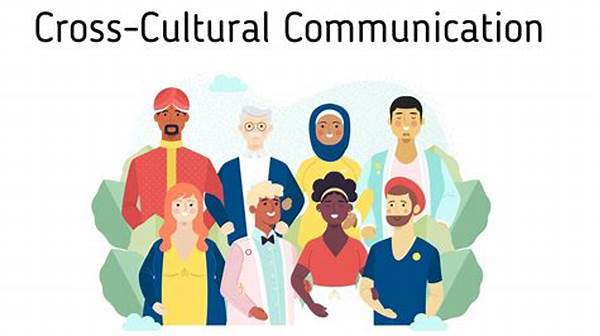In the era of globalization, the world has become a melting pot of diverse cultures. One area significantly influenced by this cultural convergence is education. The impact of cross-cultural interaction on education cannot be understated, as it presents both opportunities and challenges that require careful examination and understanding. The exposure to different cultural perspectives enriches the educational experience and promotes the development of a more rounded worldview among students.
Read Now : Methods For Evaluating Student Performance
The Positive Outcomes of Cross-Cultural Interaction
Cross-cultural interaction in educational settings offers various benefits that have the potential to transform traditional learning environments. Firstly, it enhances the cultural competence of students by encouraging them to appreciate and respect diverse cultures and traditions. This newfound awareness promotes inclusivity and reduces prejudices and biases. Secondly, it prepares students for future global engagements by developing critical soft skills such as communication, adaptability, and problem-solving. Thirdly, the impact of cross-cultural interaction on education can be seen in the encouragement of creativity and innovation. Exposure to different cultural practices and ideas inspires students to think outside the box and approach problems from unique perspectives. Moreover, students develop empathy and tolerance, which are essential traits in a progressively multicultural world. Lastly, educators also benefit from these interactions as they are prompted to adopt more inclusive and diverse teaching methodologies, ultimately enhancing their overall effectiveness in the classroom.
Challenges Arising from Cross-Cultural Interaction
Despite its advantages, the impact of cross-cultural interaction on education also presents certain challenges. Firstly, language barriers can impede effective communication between students and educators, leading to misunderstandings and a potential decrease in academic performance. Secondly, cultural differences may result in varying expectations regarding education, discipline, and behavior, which can create friction between students and teachers from different backgrounds. Thirdly, there is the risk of cultural homogenization, where minority cultures may be marginalized, leading to a loss of cultural diversity. Additionally, educators may struggle to accommodate the vast array of cultural backgrounds within a single classroom, which, in turn, impacts their ability to deliver tailored and relevant content effectively. Lastly, the process of cross-cultural interaction requires substantial resources, time, and commitment, which may strain the facilities and finances of educational institutions.
Strategies to Enhance Cross-Cultural Interaction
Acknowledging the impact of cross-cultural interaction on education, it is imperative to implement strategies that maximize its benefits while minimizing the associated challenges. Cultural exchange programs are an essential tool, allowing students to immerse themselves in different cultural settings and gain invaluable experiences. Integrating multicultural education into curricula is equally important, as it ensures that students learn from diverse narratives and viewpoints. Additionally, fostering a multicultural environment within educational institutions encourages open communication and interaction among students of different backgrounds. Teacher training and professional development programs focusing on cultural competence can equip educators with the skills needed to manage a multicultural classroom. Finally, addressing language barriers through bilingual education and language support services is crucial to ensure effective communication and understanding.
The Role of Educators in Cross-Cultural Interaction
The impact of cross-cultural interaction on education is, to a large extent, contingent on the role of educators. They are instrumental in creating a welcoming and inclusive environment that celebrates diversity. Educators must possess a deep understanding of various cultural perspectives and demonstrate sensitivity when addressing cultural differences. By establishing open lines of communication, they can facilitate the exchange of ideas and experiences among students from diverse backgrounds. Moreover, educators should strive to incorporate cultural references and materials in their teaching to bridge cultural gaps and foster a sense of belonging among all students. Through professional development and training, educators can enhance their intercultural competence, enabling them to manage the complexities of a multicultural classroom effectively.
Read Now : Fashion Design Skills For The Future
Impact on Student Development
The impact of cross-cultural interaction on education significantly influences student development. Exposure to diverse cultures broadens students’ horizons, encouraging them to embrace differences and develop empathy towards others. This experience cultivates a sense of global citizenship, empowering students to contribute positively to an interconnected world. Furthermore, by participating in cross-cultural dialogues, students refine their communication and collaboration skills, which are essential in the contemporary workforce. The diversity of cultural experiences fosters a learning environment where creativity and innovation thrive, as students are inspired to think critically and engage meaningfully with complex global issues.
Preparing for a Globalized Future
In conclusion, the impact of cross-cultural interaction on education is profound and multifaceted. As globalization advances, educational institutions must recognize the value of nurturing a culturally diverse learning environment. By implementing strategies that enhance cross-cultural interaction, educators can prepare students for a future characterized by international collaboration and intercultural understanding. Embracing cultural differences and fostering mutual respect is not only essential for personal development but also for creating a more inclusive and harmonious global community. As students navigate this ever-changing landscape, the education system must adapt and evolve to ensure they are equipped with the knowledge and skills needed to succeed in an increasingly interconnected world.
